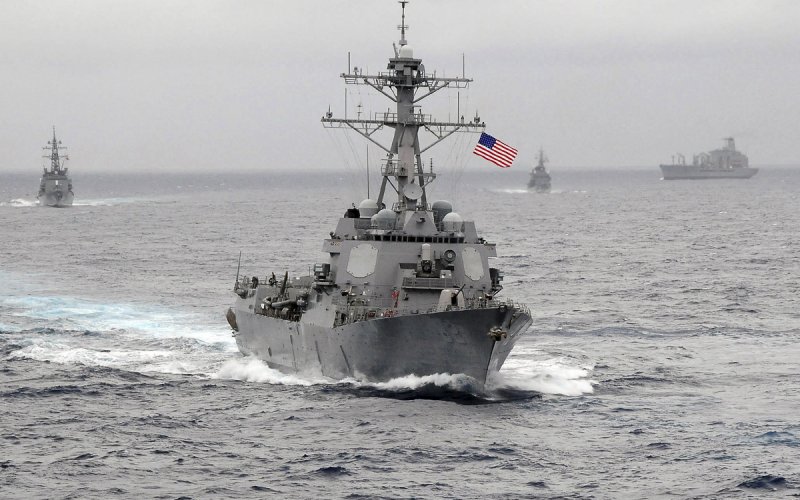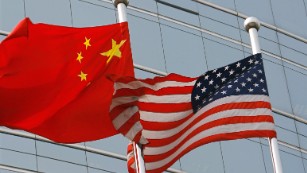China said it warned and tracked a U.S. Navy warship as it came very close to one of its artificial islands in the South China Sea’s contested waters.
China’s Foreign Ministry said in a statement Tuesday that the vessel “illegally entered into the waters of China’s Spratly Islands.”
“The action taken by the U.S. warship has threatened China’s sovereignty and security interest, and has put the safety of personnel on the reefs in danger,” the ministry said.
A U.S. defense official told CNN that the destroyer USS Lassen “conducted a transit” within 12 nautical miles of Subi Reef in the Spratly Islands on Tuesday morning local time.
The operation put the ship within an area that would be considered Chinese sovereign territory if the U.S. recognized the man-made islands as being Chinese territory, the official added.
The United States hadn’t breached the 12-mile limit since China began massive dredging operations to turn three reefs into artificial islands in 2014 — even though maritime law doesn’t usually accord territorial waters to islands built on previously submerged reefs.
Chinese government: Don’t push us
On Tuesday, the Chinese Ministry of Foreign Affairs warned of consequences if a country caused trouble or raised tensions in the territories China claims as its own.
Why China’s island-building is raising eyebrows
“If any country thinks that, through some gimmicks, they will be able to interfere with or even prevent China from engaging in reasonable, legitimate and legal activities in its own territories, I want to suggest those countries give up such fantasy,” ministry spokesman Lu Kang said.
“In fact, if relevant parties insist on creating tensions in the region and making trouble out of nothing, it may force China to draw the conclusion that we need to strengthen and hasten the buildup of our relevant capabilities. I advise the U.S. not to create such a self-fulfilling prophecy.”
Rival claims
The South China Sea is the subject of numerous rival and often messy territorial claims, with China, Brunei, Malaysia, the Philippines, Taiwan and Vietnam disputing sovereignty of several island chains and nearby waters.
In little more than 18 months, China has reclaimed more than 2,000 acres at three main locations in the Spratly Islands — Subi, Mischief and Fiery Cross reefs, where it’s building airstrips thought to be capable of handling bombers.
China’s Foreign Ministry reiterated that its activity in the South China Sea didn’t affect freedom of navigation by sea or air but said it held “indisputable sovereignty over the Spratly Islands and its nearby waters.”
“China is resolutely opposed to any country damaging China’s sovereignty and security interest in the name of freedom of navigation and overflight,” it said.
In May, a U.S. surveillance plane carrying a CNN crew swooped over the Spratly Islands, triggering eight warnings from the Chinese navy to back off.
Chinese navy ships entered U.S. territorial waters off Alaska in September, coming within 12 miles of the coastline during President Barack Obama’s visit to the state, U.S. officials told CNN at the time.
The officials emphasized that China’s actions were consistent with “innocent passage” under international maritime law.
‘Routine operation’
Another U.S. defense official told CNN that the operation was “routine” and was in accordance with international law.
“We will fly, sail and operate anywhere in the world that international law allows,” the official said.
“U.S. Freedom of Navigation operations are global in scope and executed against a wide range of excessive maritime claims, irrespective of the coastal state advancing the excessive claim,” the official added.
His comments echoed those of State Department spokesman John Kirby on Monday, who said one country didn’t need to consult another “when you are exercising the right of freedom of navigation in international waters.”
The rest of the region, wary of China’s intentions in the disputed waters, is likely to welcome the U.S. move.
Japan’s Chief Cabinet Secretary Yoshihide Suga declined to comment on the operation but said “it was extremely important that the international community work together in order to protect open, free and peaceful ocean.”
Australia said it “strongly supports” the rights of all countries to travel through the South China Sea.
Taiwan said it rejected China’s claim of sovereignty over the Spratly archipelago and called for dialogue to resolve the dispute peacefully.
Challenge?
Greg Poling, director of the Asia Maritime Transparency Initiative at the Center for Strategic and International Studies in Washington said that the U.S. operation was aimed at testing control of the seas, not sovereignty over the disputed islands, and would present a dilemma for China.
“It forces a clarification of China’s claims. China’s strategy in the South China Sea is one of ambiguity,” he said.
Poling said under maritime law, artificial islands were not usually afforded the 12-mile territorial zone, and that the U.S. Navy deliberately chose to send the destroyer near Subi Reef for this reason.
Before China’s recent land reclamation, both Subi and Mischief reefs were submerged at high tide, while a sandbar was visible at high-tide at Fiery Cross Reef, which could make its legal status more ambiguous.
“So if Beijing objects by saying to the U.S. you’re in our territorial sea, then the U.S. can respond by saying there’s no such thing as a territorial sea for an artificial island,” Poling said.
He said that the decision to go ahead with the mission follows months of discussion in Washington and likely followed Chinese President Xi Jinping’s trip to Washington last month, which made little headway on the South China Sea.
















